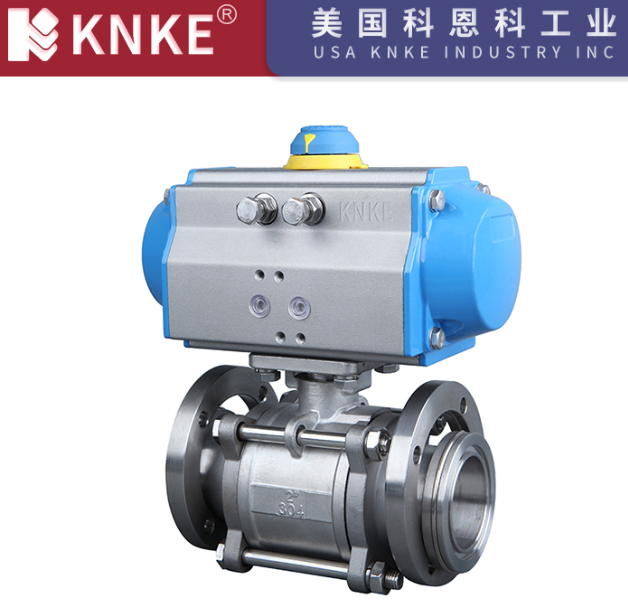Maintenance and Care of Pneumatic Valves
Pneumatic valves play a crucial role in industrial systems by controlling the flow of gases or liquids. Proper maintenance and care of pneumatic valves are essential for ensuring their longevity, reliability, and optimal performance. This article provides essential maintenance tips to help you take care of pneumatic valves effectively.

1. Cleaning the Pipe and Valve Flow Sections Before Use
Before installation or use, the pipe and valve flow sections should be thoroughly cleaned. This step is crucial for preventing metal debris, rust, and other contaminants from entering the valve body. Ensuring that the entire fluid system is clean helps prolong the life of the pneumatic valve and maintains its performance.
2. Releasing Internal Pressure of the Valve Body
Even when a pneumatic ball valve is closed, some medium may remain inside, causing internal pressure. Before performing any maintenance, it is essential to close the upstream shut-off valve, open the valve to be serviced, and fully release the internal pressure. For electric or pneumatic ball valves, ensure the power and air sources are disconnected before proceeding with maintenance.
3. Protecting Seals During Cleaning
Soft-seal ball valves typically use PTFE (Teflon) as the sealing material, while hard-seal valves use metal welding for sealing surfaces. When cleaning pneumatic valves, caution is necessary during disassembly to prevent damage to seals or sealing surfaces, which could result in leaks. Special care should be taken when cleaning pipeline ball valves to avoid damaging any seals or seals, which are essential for maintaining a leak-free operation.
4. Proper Disassembly of Flanged Ball Valves
When disassembling a flanged ball valve, the bolts and nuts on the flange should be tightened in stages. First, tighten all bolts slightly, then gradually tighten them evenly. If individual bolts or nuts are tightened prematurely, the flange surface may become unevenly stressed, potentially causing gasket damage or rupture and leading to media leakage. Proper tightening ensures a secure and leak-free seal.
5. Choosing the Right Cleaning Solvents
For cleaning pneumatic ball valves, the solvent used must be compatible with the valve parts and not cause corrosion. For gas ball valves, gasoline can be used for cleaning, while other components can be cleaned with standard water. When cleaning, ensure all dust, grease, and other contaminants are thoroughly removed. If water is insufficient, alcohol or other appropriate solvents can be used, provided that the valve body and components are not damaged. After cleaning, allow any cleaning solvents to fully evaporate before reassembling the valve.
6. Handling Minor Leaks
If minor leaks occur at the stuffing box during operation, it may be necessary to slightly tighten the valve stem nut to stop the leak. However, this should be done cautiously to avoid over-tightening. Once the leak is sealed, do not continue tightening the nut, as excessive force could damage the valve.
7. Storage and Re-Testing of Valves
Pneumatic valves that are stored outdoors for extended periods may suffer from rust and corrosion, which can lead to failure. Valves should be stored in a dry, moisture-free environment, and the flanges should be tightly sealed to prevent contamination. If a valve has been in storage for over 12 months, it should be re-tested before being used to ensure its performance is still stable.
Frequently Asked Questions (FAQ)
Q1: How often should pneumatic valves be cleaned and maintained?
A1: Pneumatic valves should be cleaned and maintained regularly, depending on the operating environment. It is recommended to perform maintenance at least once a year, or more frequently in harsh environments or when the valve is exposed to high wear and tear.
Q2: Can I use any solvent to clean pneumatic valves?
A2: No, it’s important to use solvents that are compatible with the valve materials. For example, gasoline can be used for cleaning gas ball valves, while alcohol or water-based solutions may be used for other components. Always ensure the solvent is non-corrosive and will not damage the valve parts.
Q3: What should I do if my pneumatic valve leaks slightly?
A3: If minor leaks are noticed, tightening the valve stem nut can stop the leak. However, it’s crucial not to overtighten the nut, as this can cause damage to the valve. If the leak persists, further inspection or replacement of parts may be necessary.
Q4: How should pneumatic valves be stored?
A4: Pneumatic valves should be stored in a dry, moisture-free location to prevent rust and corrosion. It is also important to seal the flanges properly and perform a performance test if the valve has been in storage for over 12 months.
Proper maintenance and care of pneumatic valves are vital for ensuring their efficient operation and prolonging their lifespan. By following these simple yet effective maintenance tips—such as cleaning, pressure release, and correct storage—you can prevent premature wear and avoid costly repairs or replacements. Always ensure you use compatible cleaning materials, handle valves with care during disassembly, and check for leaks regularly. With proper attention, your pneumatic valves will continue to perform optimally for many years to come.
